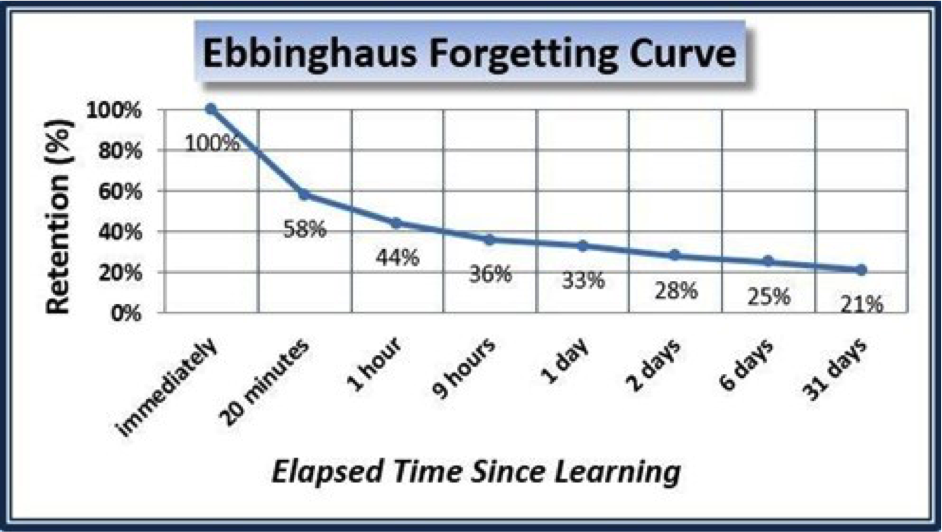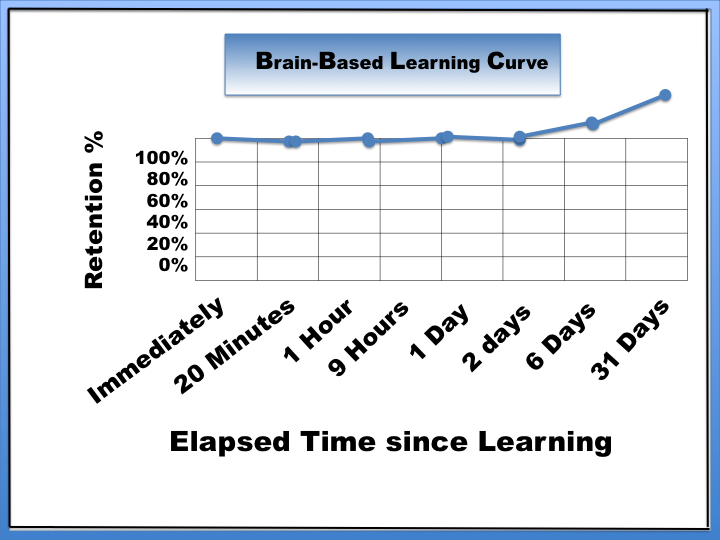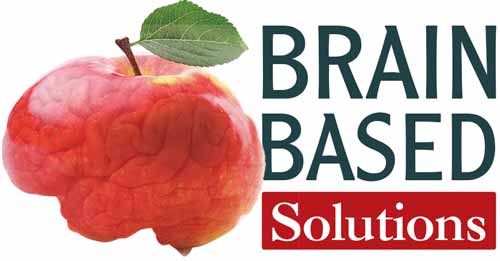Guest Contribution: Thanks to Gunner Argo, Neural Education Champion and Educator, for commentary and teacher perspective contribution to the discussion about Ebbinghaus’ Forgetting Curve based on Dr. O’Mahony’s publication (International Conference on E-Learning in the Workplace -ICELW, Columbia University Teachers College, 2019)
12-0-26. Over twenty-five years later, I can still remember my middle school locker combination.
For some odd reason, that series of numbers has been encoded into my long-term memory and has lingered, unused, for a quarter of a century. I can’t tell you what locker number it was, or who was in the lockers next to me, but I do remember the combination.
Memory is a tricky thing. What stays? What goes? And, is there a way to make sure that we actually remember the stuff we want to remember?
One of the most widely referenced theories on memory is German psychologist Hermann Ebbinghaus’ “forgetting curve.” Here’s how it works.
What is the Forgetting Curve?

The basic premise of Ebbinghaus’ theory comes from a series of experiments that he performed on his own self to answer the question: how much can we really remember?
To find out, he studied nonsense syllables, then measured how many he could remember at different intervals of time. Using the data he collected, he came up with an equation to calculate how much data could be retained over a given period of time without any attempt to practice or recollect it.
According to his theory, a certain percentage of newly learned items would be forgotten over time, with 90% being lost within 30 days. But, this isn’t always the case, is it?
Sometimes information stays much longer in our memory, and other times it is forgotten almost immediately. Different types of memories and pieces of information have better chances for retention than others, and not all thinking is the same.
Ebbinghaus deliberately chose nonsense words for his study. Specifically, three letter syllables with two consonants and a vowel in the middle or three consonants. For example, WSP, LXK, or SEH. Ebbinghaus did this so that he could claim no association with the items being memorized that would affect his ability to recall them. He writes:
These materials [poetry and prose] bring into play a multiplicity of influences that change without regularity and are therefore disturbing. Such are associations which dart here and there, different degrees of interest, lines of verse recalled because of their striking beauty, and the like. All this is avoided with our syllables. (Ebbinghaus 1885/1913, p.23)
Ebbinghaus knew that it wasn’t just how we learned, but what we learned that determined its likelihood for retention.
What We Learn Changes Our Retention
For the most part, Ebbinghaus’ theory holds true. If a new piece of information is acquired it will most likely be forgotten without practice, repetition or intentional retrieval.
But this is not true for all learning, as not all learning is the same.
In most cases, the information that we hope to retain over time is never just unrelated syllables with no connection to other memories. We want to remember complex ideas, experiences, and concepts.
A myriad of factors will determine what we remember and what we do not. The difference between a visual memory or an olfactory memory matters. The emotional state we were in when it was received matters. Whether we are recalling a specific data point, a concept, or the connections we may already have to new information matters. These all factor into our brain’s ability to code a short-term memory into a long-term memory.
The idea that there is a mathematical formula for memory was revolutionary at the time. But, in the century since it was published, our scope of knowledge and understanding of the brain has drastically altered what we believe about the limitations of memory. The premise that repeated exposure over time to information increases the duration of memory is obvious, but what about improving the quality of the exposure or the condition of the brain to learn?
How to Enhance Memory Retention with Brain-Centric Teaching

The key to increasing the understanding and duration of what we learn is to focus teaching practices through a neural lens.
A brain-centric teaching model challenges the idea that traditional teaching practices offer the most effective way to learn. The emphasis of a brain-centric teaching model is not to change content or adjust learning targets. It is to increase the potential for learning with deep understanding and, thus, memory retention.
Focusing on a neurological approach to education is not about adjusting learning targets, or improving methods for hitting targets, but increasing the size of the bullseye.
The forgetting curve was founded on the idea that retention of new information has no connection with previous learning, personal interest, or investment because these would alter results. But this is precisely the alteration that needs to be addressed.
Knowledge, skills, and proficiency do not exist within a vacuum in the human mind. Our emotional state, personal interest, and outside factors do have an impact on how we learn and what we remember.
The focus of a brain-centric learning model is to leverage these factors in order to enhance the effectiveness of the learning environment.
Brain-Centric Learning in the Business World
A 2019 study focused on the training methods of a large United States-based manufacturing and retail corporation. The purpose of the study was to improve the return on investment for new hires within their organization. The development of knowledge and expertise in an area takes time and resources. In an area where there is a high level of attrition or employee turnover, the cost of maintaining a proficient staff can become disproportionately expensive if the training process is ineffective.
However, we can increase the return on investment in an organization if the trainees learn the material faster and more thoroughly. Trainees are also less likely to quit if they feel prepared for a job, and their performance increases when they feel confident in their mastery of the tasks. This is not only true for manufacturing and retail but in any setting where education is needed for development.
The study was based on two groups, one that was trained using traditional teaching methods: “sit and get” or “sage on a stage,” and one that was trained using a brain-centric program focused on a neurologically based framework.
Four areas of measurement were used to examine the results:
1) Speed to green – the length of time needed for a participant to reach a specified level of proficiency.
2) Agent Performance – satisfaction level reported by customers interacting with participants after completing their training.
3) Agent Attrition – how many participants quit the program during the training cycle.
4) Conversion rates/sales – measurement of positive customer interactions in terms of sales.
The results? The brain-centric learning cohort showed:
- Faster results. The brain-centric learning cohort was the fastest group in the history of the organization to achieve proficiency in training. The results from the traditional teaching methods usually lasted from six to nine months, while the brain-centric training group reached proficiency in only three.
- Reduced employee turnover. Additionally, this group also had fewer participants leave the program during training (from 17% to 2%) and within two weeks of completing the training program (from 7% to 5%).
- Increased customer satisfaction. The brain-centric group also showed an increase in customer satisfaction after completing their training. Customer feedback reported higher levels of satisfaction with happy customers and lower levels of dissatisfaction with unhappy customers.
- Better sales. The brain-centric group sales numbers out-performed the traditionally trained group each of the three successive months, indicating that the duration of the learning had increased as well.
Overall, the group that was trained under the brain-centric designed program were trained faster, more effectively, and produced better returns than those trained under traditional models. This improved the bottom line of the retail organization’s return on investment by millions of dollars.
While the increase in profits shows the success of the shift in teaching and learning trials, the trainers and participants also reported the training cycle was more fun, innovative, and easier to learn in.
A brain-centric model focuses on creating an environment that increases personal investment and interest. Indeed, this model proves to be key to more effective teaching and learning opportunities from factories to classrooms.
Brain-Centric Learning in the Classroom
In recent years, there has been a rolling murmur about changes needed for a ‘broken’ education system in the United States.
There have been very few revolutionary changes in education since the establishment of the “common schools” championed by Horace Mann in the mid 19th century, and our departure from the industrial age has shifted our views on what students need in order to be successful in life.
The proliferation of easy access to nearly limitless data via the internet has spawned the phrase “we need to teach kids HOW to think, not what to think.” These technological advancements have not solidified what these changes are but made them much more unclear. We have become somewhat trapped by a ‘chicken or egg’ scenario as we grapple with deciding what to change first: what we teach, or how we teach.
Shifting to a brain-centric model changes the focus to how students learn. This teaching model is not about making more effective teachers, but developing environments that help maximize the potential of the learning machine that is the human brain.
Developing a teaching model that incorporates factors of learning such as personal connection, autonomy, interest-based understanding and conceptual mastery are grounded in neurological principles of best learning practices.
Why do I remember my 7th-grade locker combination? Could it be that I spent an entire year coming back to that number on a daily basis? Well, I also did that for my 8th-grade combination and I have no recollection of what that number was.
The truth is, it was my first locker. Primacy. It symbolized my transition from elementary school to middle school. It was connected with something important to me emotionally as something I was personally invested in. It gave me a sense of independence; intrinsic autonomy.
It was a combination of these brain-centric principles that helped my memory hold on to those numbers in spite of the forgetting curve and twenty-five years of never practicing it again.
These are the same strategies that can be implemented in our classrooms to make more effective learners.
Return to the blog to discover more brain-based learning resources.

